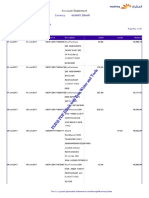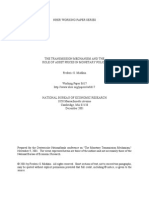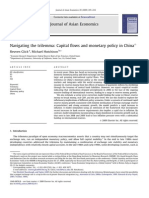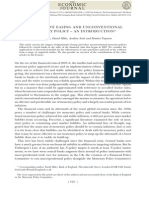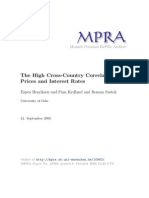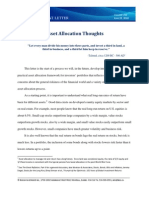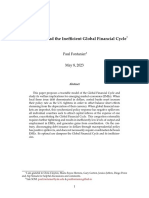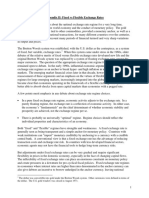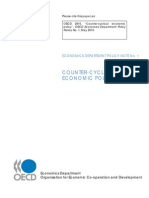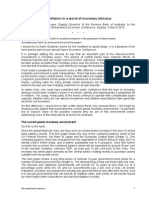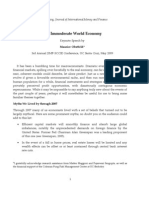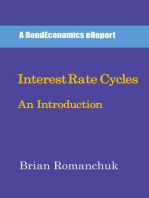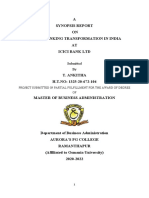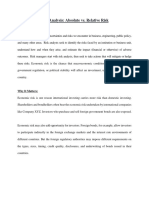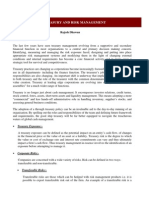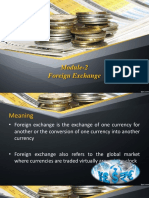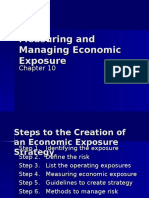Carry Trades, Monetary Policy and Speculative Dynamics
Carry Trades, Monetary Policy and Speculative Dynamics
Uploaded by
Sherwin RicaflancaCopyright:
Available Formats
Carry Trades, Monetary Policy and Speculative Dynamics
Carry Trades, Monetary Policy and Speculative Dynamics
Uploaded by
Sherwin RicaflancaOriginal Title
Copyright
Available Formats
Share this document
Did you find this document useful?
Is this content inappropriate?
Copyright:
Available Formats
Carry Trades, Monetary Policy and Speculative Dynamics
Carry Trades, Monetary Policy and Speculative Dynamics
Uploaded by
Sherwin RicaflancaCopyright:
Available Formats
Carry Trades, Monetary Policy
and Speculative Dynamics
Guillaume Plantin
Toulouse School of Economics and CEPR
guillaume.plantin@tse-fr.eu
Hyun Song Shin
Princeton University
hsshin@princeton.edu
This version, January 2011
Abstract
We ask when currency carry trades are associated with destabilizing
dynamics in the foreign exchange market, and investigate the role of
monetary policy rules in setting o such dynamics. In a model where
the exchange rate has a long-term fundamental anchor, we nd that
carry trades can be stabilizing or destabilizing at shorter horizons,
depending on the propensity of capital inows to overheat the recipient
economy. In the destabilizing case, we solve for a unique equilibrium
that exhibits the classic pattern of the carry trade recipient currency
appreciating for extended periods, punctuated by sharp falls.
JEL codes: F31, F41
Keywords: Currency crises, emerging market bubbles, speculation
This paper supersedes our earlier paper entitled Carry Trades and Speculative Dy-
namics. We thank Patrick Bolton, Doug Diamond, Urban Jermann, Pete Kyle, Karen
Lewis, Ady Pauzner, Lasse Pedersen, Richard Portes, Helene Rey, Tano Santos, Jeremy
Stein, and Dimitri Vayanos for their comments on earlier drafts.
1
1 Introduction
Low interest rates maintained by advanced economy central banks in the
aftermath of the 2008 nancial crisis have ignited a erce debate about
capital ows to emerging economies. The accusation is that such capital
ows are driven by speculative carry trades that unduly destabilize exchange
rates by seeking to exploit the interest rate dierences between advanced and
emerging economies. Beyond the debate in the policy blogosphere and in
the nancial press
1
, there is much that remains to be understood about
the mechanisms underpinning the link between monetary policy and capital
inows.
One set of questions turns on whether speculative trading is stabilizing
or destabilizing. Milton Friedman (1953) famously argued for the sta-
bilizing eect of speculation when arbitrageurs, anticipating an eventual
reversion of prices to some fundamental value, take positions that hasten
the adjustment. Against this, many commentators have emphasized the
role of monetary policy rules that increase the potential for carry trades to
be associated with destabilizing speculation that take exchange rate away
from some perceived fundamental value. In an ECB policy paper on the
global spillovers in monetary policy, Moutot and Vitale (2009) argue that
the spread of ination-targeting and other monetary policy rules that raises
policy rates in reaction to overheating domestic economic conditions may ac-
tually exacerbate capital inows and undermine the eectiveness of higher
interest rates in dampening demand.
For emerging economies, the interaction between domestic monetary pol-
icy and capital inows can pose particularly dicult challenges in cooling an
an overheating economy. An IMF working paper (Kamil (2008)) describ-
ing the experience of Colombia lays out the policy dilemma in the following
terms.
Foreign investors, realizing that the central bank would eventu-
ally focus on taming ination (and eventually let the exchange
rate appreciate), took unprecedented amounts of leveraged bets
against the central bank in the derivatives marketthereby lim-
iting the eectiveness of intervention. Paradoxically, then, the
[Colombian central banks] perceived strong commitment to in-
ation actually undermined its ability to inuence the exchange
rate. [Kamil (2008, pp.6-7)]
1
See, for instance, the full page feature in the Financial Times entitled Carried Away,
April 30th, 2010.
2
Although the above quote is for Colombia, the same words could be
applied to many other economies, especially in the aftermath of the global
nancial crisis where we have the conjunction of low U.S. dollar interest rates
but booming emerging economies with surging capital inows. Of the large
economies, the case of Brazil has attracted particular attention due to its
combination of high nominal interest rates and evidence of an overheating
economy.
2
In this paper, we ask when carry trades are liable to trigger destabilizing
speculation in the foreign exchange market, and ask what role monetary
policy plays in the speculative dynamics. We pose this question in a model
of exchange rates that are anchored in the long-run to some known economic
fundamentals, but where short-term speculative activity may push the ex-
change rate away from this known long-run fundamental value. We show
that the model is general enough to accommodate both the stabilizing mode
of speculative activity in the manner of Friedman (1953), but is also capable
of generating destabilizing dynamics where speculators actions to engage in
the carry trade take on the attributes of strategic complements - that is,
the action by other speculators to engage in the carry trade increases the
attractiveness of engaging in the carry trade oneself.
Crucially, whether speculative activity is stabilizing or de-stabilizing de-
pends on the monetary policy rule used by the capital recipient economys
central bank. The more sensitive is the recipient economy to overheating
due to capital inows, the more sensitive is the central banks monetary
policy rule to such inows. But then, greater capital inows fuel further
increases in the interest rate of the recipient country, increasing the attrac-
tiveness of the carry trade, and fuelling the capital inows. We show that
when the conditions are right, the interaction between capital inows and
monetary policy can create a vicious circle that encourages destabilizing
carry trade inows.
Perhaps the poster child for the perverse interaction between monetary
policy and carry trade inows is Iceland in the run-up to the 2008 nan-
cial crisis. Even before the carry trade took on signicant proportions,
Iceland was already an overheating economy. The central bank had em-
braced ination targeting in 2001, and kept ocial rates at high levels to
try and curb an investment and consumption boom. The high interest rate
dierential fuelled capital inows via the banking sector and through the
2
Brazil recently raised its benchmark selic rate to 11.25% from 10.75%. See the WSJ
article on Jan 20, 2011 Brazil Raises Key Interest Rate at:
http://online.wsj.com/article/SB10001424052748704590704576092471442713938.html
3
issuance of eurobonds - the so-called glacier bonds (see Jonsson, p. 70)
that were used to fund investment projects in Iceland. The outstanding
notional amount of glacier bonds culminated above 30% of Icelandic GDP.
Unsurprisingly, such large inows led to a sharp appreciation in the Krona
combined with overheating in the domestic economy. In particular, for
reasons discussed below, the exchange rate appreciation did not have im-
portant demand-switching eects that could have oset the expansionary
impact of foreign capital inows. Thus, the carry trade exerted a positive
feedback on ocial rates. As Iceland raised interest rates in response to the
overheating economy, the higher interest rate dierential attracted capital
inows that fuelled the investment boom that exacerbated the overheating
economy. The ination-targeting central bank raised interest rates further
in response, giving a further twist to the vicious circle of an appreciating
exchange rate and further capital inows.
In the case of Iceland, several specic factors explain why this feedback
loop between capital inows and interest rates has been particularly strong.
First, capital inows fuelled a housing boom, and housing prices entered
the CPI in Iceland, creating an almost mechanical link between carry trades
and ocial rates (see Jonsson p.69). Also, exchange rate appreciation had
limited impact in cooling down the economy due to the nature of domestic
output. For example, a large fraction of Icelandic exports is sh, subject
to binding regulatory constraints on catch volume, and thus not sensitive
to price uctuations. Also, most productive investments were long gesta-
tion projects related to (U.S. dollar denominated) commodities, by nature
quite inelastic to the krona/yen or krona/euro exchange rates. The Chief
Economist of the Central Bank of Iceland discusses the role of these factors
and others in the apparent ineectiveness of the exchange rate channel at
cooling down the economy in Sighvatsson (2007).
The role of the housing and commodity sectors were also important in
New Zealand, another important destination economy for carry trade inows
before the 2008 crisis. Our model will actually be posed in terms of the
pre-crisis carry trade scenario where the funding currency is Japanese yen,
and the destination currency is the New Zealand dollar. In our model,
investors consume in yen but contemplate making deposits in New Zealand
so as to benet from the interest rate dierential. The interest rate on New
Zealand dollar is set with the primary goal of stabilizing ination. Capital
inows boost domestic output and raise inationary pressures. In addition,
exchange rate uctuations aect the price level of the traded fraction of
consumption, but NZ dollar appreciation has limited demand composition
eects that could cool down the economy.
4
With this basic set-up, we build our theoretical framework in two steps.
First, we consider a simple deterministic version of our model and ascertain
the conditions under which the actions across speculators to engage in the
carry trade are strategic substitutes or strategic complements. We show
that both cases are possible, and point to the crucial role played by the
monetary policy reaction function of the recipient country in determining
the answer. When carry trades are strategic complements, self-fullling
departures from the steady state can be supported in equilibrium, much as
in the vicious circle described for Iceland above.
Our fully developed theoretical framework develops the basic model by
introducing small exogenous noise which leads to the selection of a unique,
dominance-solvable equilibrium in the game played by speculative traders.
Our equilibrium selection technique draws on the tools developed by Frankel
and Pauzner (2000) and Burdzy, Frankel and Pauzner (2001) to solve dy-
namic coordination games. We show that our model is capable of generating
the typical time path of exchange rates associated with carry trade recipi-
ent currencies where extended periods of slow appreciations of the high rate
currency are stochastically punctuated by endogenous crashes. Currency
traders refer to such extreme patterns as going up by the stairs and coming
down in the elevator (see Breedon, 2001)
3
.
In the unique equilibrium, the exchange rate exhibits history-dependence
and depends on a highly nonlinear fashion on exogenous shocks. There are
two forces that drive such speculative dynamics. First, cumulative foreign
investment boosts output and thus ocial rates. Second, ination expec-
tations contribute to support these dynamics. When the size of the carry
trade is large, it also implies that the carry trade has a small upside risk and
a large downside risk because the dollar is overvalued and the economy is
near full capacity. This asymmetric risk prole goes against coordination on
the continuation of the carry trade. But this skewed risk prole is partially
compensated by the fact that imported ination risk is accordingly skewed
in the opposite direction, which helps to foster coordination on speculative
dynamics. In the case of small exogenous shocks, closed-form solutions
generate insights into the impact of the primitive parameters of the model
on the nature of the price paths. Slower-moving carry traders, and more
active monetary policy lead to more bubbly exchange rate paths, with
more history-dependence, and more rare and dramatic episodes of the New
Zealand dollar going down in the elevator.
3
Gagnon and Chaboud (2007), Gyntelberg and Remolona (2007) and Brunnermeier,
Nagel and Pedersen (2009) document the skewed nature of carry trade returns.
5
Related Literature
This paper relates to several strands of literature. Although our model
does not address asset pricing issues directly, the equilibrium price paths in
our paper that reproduce the pattern of going up by the stairs and coming
down in the elevator are suggestive of skewed distributions of outcomes and
the possible explanatory role of the peso problem in the foreign exchange
markets. In a series of papers, Burnside, Eichenbaum, Kleshchelski and
Rebelo (2006, 2007, 2008) have explored the extent to which conventional
asset pricing models can explain the returns to carry trade positions, and
point to the importance of rare jumps in the stochastic discount factor itself
- a form of peso problem. Burnside (2010) is a recent further exploration
of the limits of traditional risk factors to account for returns on foreign
exchange markets, and how broadly applicable such risk factors are to tra-
ditional asset markets. Brunnermeier, Nagel and Pedersen (2009) pursue
the link between carry trades skewed distributions of outcomes for funding
and destination currencies in the carry trade, while Farhi and Gabaix (2009)
argue that the possibility rare disasters can account for the excess returns
associated with carry trades.
Our paper has points of contact with the strand of the literature where
coordination motives enter in speculative decisions by economic agents, such
as the collective moral hazard model of Farhi and Tirole (2010) or Schnei-
der and Tornell (2004). In these models, the government bails out specula-
tors if their aggregate losses are suciently large. This creates a coordination
motive among speculators. Excessively risky positions become attractive if a
suciently large number of speculators crowd into them, because it activates
the put induced by the bailout. This creates room for multiple equilibria.
Speculators in our setup coordinate to induce a high interest rate on their
NZ dollar holdings. Our main contribution to this literature is to develop
a model in which, instead of multiple Pareto-ranked steady-states, similar
externalities generate a unique equilibrium path with endogenous triggers of
bubble-and-crash-like patterns. In particular, our closed-form equilibria
are useful to understand how the probability and severity of such bubbles
and crashes vary with the strength of positive externalities among traders.
Given the important debate on the role of collective moral hazard in the
recent nancial crisis, we believe that our approach is a useful rst step to-
wards more applied and quantitative models of coordination-based nancial
instability.
Third, our model of sequential trading at random discrete dates relates
to the literature on asset pricing with search frictions pioneered by Due,
6
Garleanu, and Pedersen (2005). This literature has recently studied liquidity
crises by developing models of out-of-steady-state price dynamics (see, e.g.,
Lagos, Rocheteau, and Weill, 2010). Our approach is complementary. We
make a number of simplifying assumptions that renders the determination of
asset prices more straightforward than in these papers. The gain from these
more stylized aspects of our setup is that we fully characterize a stochastic
steady-state with interesting nonlinear price dynamics.
Finally, the tools developed by Frankel and Pauzner (2000) and Bur-
dzy, Frankel and Pauzner (2001) are reminiscent of the solution to static
coordination games with private information - global games - introduced
by Carlsson and van Damme (1993), and popularized by Morris and Shin
(1998). The global-game framework relies on simultaneous actions at each
date, and on the presence of very accurate private information. The ap-
proach developed by Burdzy, Frankel, and Pauzner seems better suited to the
foreign exchange market for two reasons. First, we assume sequential trades,
which arguably describes decentralized over-the-counter markets such as the
FX market better than simultaneous submissions of market orders. Second,
equilibrium uniqueness in our setup does not rely on the presence of private
information. This again seems appropriate in the case of FX markets in
which it is unlikely that material private information be available to inside
traders.
2 Model
Time is continuous and is indexed by t [0, +). There are two curren-
cies, Japanese yen and New Zealand dollar (simply, yen and NZ dollar
henceforth). Yen serves as the numeraire. There are two types of agents -
rst, a continuum of unit mass of carry traders (or traders, or speculators
henceforth), and second, a liquidity provider in the foreign exchange market.
Carry traders are risk-neutral and discount the future at the rate c 0.
Carry traders consume in yen but may trade yen or dollar-denominated
assets. All yen-denominated assets are in perfectly elastic supply at the
expected rate of return c. Carry traders face limits on the size of their
trading positions, both for long and short positions. For simplicity, we will
normalize the position limits and assume that a carry trader can invest a
total of at most one yen, and that short positions are not permitted.
Each carry trader has a chance to rebalance its portfolio at discrete dates
with constant arrival rate ` 0. We assume that the Poisson processes
associated with these rebalancing dates are independent across carry traders.
7
In between two such trading dates, a trader consumes instantaneous asset
returns if they are positive, or renances them if negative. This way, trading
positions - the yen amount invested in each asset - are kept constant between
trading dates.
Let r
t
denote the aggregate yen amount invested in NZ dollar assets by
the carry traders at date t. From the law of large numbers, a fraction `dt of
the carry traders have an opportunity to rebalance their portfolios at each
time interval dt, and so (r
t
)
t0
follows the law of motion given by
r
t
= `(/
t
r
t
) , (1)
where /
t
[0, 1] is the average yen amount invested in dollar-denominated
assets by traders who have a chance to readjust their holdings at date t.
We assume that there is a fundamental value of the NZ dollar to
which the exchange rate - that is, the yen amount required to purchase one
NZ dollar - will ultimately revert to, but we will allow this fundamental
anchor to be possibly quite weak in the interim. Formally, we model the
fundamental anchor in the following way. At some random date, the trading
in the foreign exchange market comes to a halt, at which time the exchange
rate reverts to its fundamental value where 0. This fundamental
value is known from the outset. All NZ dollar positions are liquidated
at this terminal date, and no further trading takes place. Figuratively, we
dub this random terminal date the day of reckoning.
The day or reckoning is a ctional device which cannot be taken lit-
erally. However, in the model, it serves the useful purpose of allowing the
fundamentals to exert an inuence on the decisions of individual traders
who trade in anticipation of its possible arrival. In terms of the model, our
interest is in the dynamics of the economic system before the arrival of the
day of reckoning.
We assume that the day of reckoning arrives according to a Poisson pro-
cess with arrival rate j 0. The arrival rate j is our way of parametrizing
the strength of the fundamental anchor on the exchange rate. The smaller
is j, the looser is the fundamental anchor and the longer the exchange rate
may deviate from its fundamental value . In the remainder, we study the
evolution of the economy before this day of reckoning occurs.
The yen return earned by a carry trader on its dollar investments be-
fore the day of reckoning is driven by two processes - the evolution of the
exchange rate and the instantaneous dollar rate of return on dollar denom-
inated assets. We now describe these two processes.
8
Determination of Exchange Rate
At each rebalancing date, carry traders meet a competitive representative
bank that is willing to trade currencies. At each date, the bank observes
the net yen order ow r
t
dt associated with traders rebalancing decisions,
and then quotes a competitive exchange rate. The bank is risk neutral and
consumes in NZ dollars. It discounts the future at the rate , which is also
the xed instantaneous rate of return on its NZ dollar balances. It earns an
instantaneous return of (j) NZ dollars when it holds a balance of j yen,
where
(j) = 1 c
nj
, : 0.
Concavity of implies that the bank has a preference for a balanced portfolio
in the two currencies, which we may motivate by an aversion to inventory
risk.
4
The particular functional form for allows us to obtain a simple
exchange rate process resulting from the carry traders decisions. For all
t 0, let j
t
denote the exchange rate - the yen amount required to purchase
one NZ dollar at date t. We have
Lemma 1 The NZ dollar exchange rate at date t is a function of r
t
only
and satises
j
t
=
c
na
:
. (2)
Proof. See Appendix A.
Determination of Dollar Return
Carry traders earn the nominal deposit rate on NZ dollars, which we assume
is identical to the ocial rate set by the New Zealand monetary authority
- the Reserve Bank of New Zealand (RBNZ). The publicly known objective
of the RBNZ is to maintain the ination rate at a constant level i, and
it uses adjustments in the ocial rate to control ination. We denote by
r
t
the instantaneous ocial rate. The New Zealand price index
t
and
domestic output j
t
are assumed to follow the following static reduced form
relationships.
First, there is a Phillips curve relationship between ination and output,
given by
t
= ij
t
j
j
t
j
t
+ c, (3)
4
Bacchetta and van Wincoop (2009) and Hau and Rey (2006) use the analogous device
of imperfect liquidity supply by currency traders with exogenous private valuations of the
currencies to determine the exchange rate.
9
where j
t
is the date t output, c, i, j are constants with i, j 0. Thus,
ination is positively related to output, and inversely related with NZ dollar
appreciation. Output follows the IS curve relationship given by:
j
t
= ir
t
(r
t
i) + /, (4)
where /, i, are constants with i, 0. New Zealand output is positively
related to the net foreign capital position r
t
, so that foreign capital inows
are expansionary.
5
However, output is negatively related to the real interest
rate r
t
i.
The timing of actions within each time interval (t, t + dt) is the following.
First, carry traders who have the opportunity to rebalance their portfolio
do so. This determines the aggregate net order r
t
dt and the exchange rate
uctuation
j
j
. Observing this, the RBNZ announces a nominal interest
rate r
t
, and output is produced. Using (4) to eliminate j
t
from (3), we see
that the RBNZ can ensure that
t
= i
with an interest rule of the form
r
t
= c j c
j
t
j
t
+ ,r
t
, (5)
where
c =
j
i
, , =
i
.
Thus c and , are large when capital inows have a large impact on output
(i large), exchange rate uctuations have an important impact on ination
(j large), the ocial rate has little impact on output ( small), and taming
ination requires large output contractions (i small). In the remainder, we
will track how the coecients c and , gure in the speculative dynamics.
We will focus on the case c < 1 because, as argued in Section 4.2, we believe
it is empirically plausible.
This modelling of the interplay of carry trades and monetary policy has
two crucial ingredients:
5
Although we measure net foreign capital in terms of
, it would be straightforward
to use instead the cumulative amount of NZ dollars that carry traders bring into New
Zealand 0 +
0
= 0 +
.
10
1. i 0. That is, purchases of NZ dollar assets by carry traders are ex-
pansionary. Notice that r
t
is related to both the foreign capital stock
and the exchange rate level. That i 0 captures that the expan-
sionary eect of foreign inows is more important than the demand-
switching impact of an expensive currency. For the reasons laid out in
the introduction, this is plausible in the economies targeted by carry
traders.
2. Carry traders move rst within each period, and the central bank sets
monetary policy to reach its ination target. In this sense the central
bank is the Stackelberg follower, and cannot commit ex ante to an
explicit policy rule.
Our modelling of monetary policy yields an interest rate rule (5) that is
linear in spot variables. This simplies the exposition, but we should say
here that more complexity could be accommodated in the analysis without
materially aecting our main conclusions. Any monetary policy rule where
the ocial rate (and hence the deposit rate) increases w.r.t to rational fore-
casts of future foreign capital stocks and decreases when the central bank
expects future exchange rate appreciation would yield similar results.
3 Stabilizing Versus Destabilizing Carry Trades
Having characterized the simple responses of the liquidity supplier and the
central bank to carry traders actions in (2) and (5), we can boil down the
problem into a simple game between carry traders. For a given initial
position r
0
, the process of rebalancing decisions (/
t
)
t0
fully characterizes
the paths for all variables in the economy until the arrival of the day of
reckoning. The instantaneous rebalancing decisions (/
t
)
t0
are the result of
maximization decisions of the carry traders who seek the highest expected
return to their portfolios.
We proceed to examine the strategic interaction between the traders,
and in particular what determines whether the carry traders decisions are
strategic substitutes or complements - in other words, whether the incentive
to engage in the carry trade is increasing or decreasing in the incidence of
the carry trade in the wider population. To gain some intuition, suppose
that a carry trader has a chance to rebalance its portfolio at some date t,
and believes that future aggregate rebalancing positions until the day of
reckoning are given by the deterministic process (/
t+&
)
&0
. Let 1
t
denote
11
the net unit return that this carry trader expects to earn by switching from
yen to NZ dollar assets. We can write this net return as follows.
Lemma 2
1
t
=
Z
+
0
c
(A+j+c)&
j
t+&
j
t+&
+r
t+&
c +j
j
t+&
j
t+&
dn. (6)
Proof. See Appendix A.
Expression (6) can be interpreted as follows. The term c
(A+j+c)&
inside
the integral sign means that the trader (with discount rate c) will hold the
portfolio chosen at date t until one of two events happen: either the next
rebalancing date arrives (with intensity `), or the day of reckoning arrives
(with intensity j). Until the rst of these two dates, the trader earns an
instantaneous return that has three components. The rst component
j
+
j
+
is the instantaneous exchange rate appreciation of the NZ dollar. The second
component r
t+&
c is the interest rate dierential between the NZ dollar
and yen. The third component j
j
+
j
+
is the capital gain/loss if the day of
reckoning arrives before the next rebalancing date.
Plugging (2) and (5) into (6), the expected return 1
t
can be written as
Z
+
0
c
(A+j+c)&
:(1 c) r
t+&
+ ,r
t+&
+j
c
na
+
1
dn,
which, by virtue of (1), further simplies into
Z
+
0
c
(A+j+c)&
`:(1 c) (/
t+&
r
t+&
) + ,r
t+&
+j (c
na
+
1) j
dn. (7)
This expression oers insights into the nature of the strategic interaction
between carry traders, and in particular whether traders decisions to engage
in the carry trade are strategic substitutes or complements. If the datet
speculator expects that the incidence of carry trades will be high in the
future (i.e. that the paths (r
t+&
)
&0
and (/
t+&
)
&0
take high values), does
the trader have an incentive to switch to NZ dollar assets at date t? If the
answer is yes, then the carry trades are mutually reinforcing and traders
actions are strategic complements. Under these circumstances, we may
expect deviations of the exchange rate from its fundamental value sustained
by self-fullling beliefs of NZ dollar appreciation or depreciation. If the
answer is no, then the situation resembles strategic substitutability, and
the exchange rate path will be self-stabilizing in that individually rational
12
actions by the traders hasten the return of the exchange rate toward its
fundamental value.
An inspection of the expression in (7) sheds some light on how parameter
values determine the answer to this question. We can see rst that if , is
large - that is, if the ocial NZ dollar rate is sensitive to carry traders
holdings at a given date r
t
- then the attractiveness to engage in the carry
trade is increasing in the future path of the incidence of carry trades as given
by (r
t+&
)
&0
. A small j also implies that the fundamental anchor that ties
the exchange rate is too weak to oset this potentially destabilizing impact
of ,. Under these conditions, the circumstances are ripe for the formation
of self-fullling deviations of the exchange rate paths from the fundamental
value.
The impact of `:(1c) on traders interactions is more subtle. This co-
ecient determines how future changes in carry traders positions /
t+&
r
t+&
aect the decisions of current carry traders. We will see in Section 4 that
large and protracted deviations of the exchange rate from its fundamental
value are more frequent when the coecient `:(1 c) is smaller. The
broad intuition is that a small `:(1 c) implies that future traders will
create limited losses for the current ones if they decide to bet in the opposite
direction from them. This makes current traders more prone to trade in the
same direction as their predecessors without the fear of being caught in the
opposite trades of their successors. Notice that this coecient is small in
particular if ination is very sensitive to exchange rate uctuations (c close
to 1). In this case, if one expects for example a future depreciation of the NZ
dollar j
t+&
= `:j
t+&
, then expectations of high future imported ination
and thus a high ocial rate mitigates the negative impact of depreciation
on total return.
The next results formalize these intuitions on the role of , and j. In
order to state the conditions on the parameters more precisely, we rst
characterize steady-states with constant exchange rate and interest rate.
By steady-state, we mean steady-state until the day of reckoning.
Lemma 3
i) Let r
(0, 1). The path /
t
= r
t
= r
for all t is a steady-state with
constant exchange rate j
=
c
n
if and only if )(r
) = 0,where
)(r) = ,r j + j
c
na
1
.
ii) Suppose
(1, c
n
) and , j. (8)
13
Then if j is suciently large or suciently small, there exists a unique
steady-state with constant exchange rate.
Proof. i) Substitute /
t+&
and r
t+&
with r
in (7).
ii) Suppose is j suciently large that
, + jc
n
< j + j < j. (9)
This implies that )(0) 0 and )(1) < 0. Since in addition
)
0
(r) = , j:c
na
is strictly increasing, )
0
must be either negative, or negative then positive.
(If it was positive, one would have )(0) < )(1).) In any case this implies
that ) has a unique zero r
(0, 1) . Consider now j suciently small that
, + jc
n
j + j j. (10)
Condition (10) implies )(0) < 0 and )(1) 0. Since )
0
is increasing, this
implies again that ) has a unique zero r
.
When such a steady-state exists, it satises a version of uncovered interest
parity that takes account of the adjustment of the exchange rate toward the
fundamental value associated with the day of reckoning. To see this, note
that in a steady-state characterized by r
we have
c + ,r
j + j
= c
A high r
means that j
is high, or that the exchange rate is perceived to be
currently overvalued given its fundamental value . Accordingly, investors
require a high instantaneous return on NZ dollar cj+,r
as compensation
for the depreciation of the NZ dollar at the day of reckoning from j
to .
The parameter j plays a key role in determining the nature of such
steady states with constant exchange rate. First, in line with the above
discussion, if j is large enough (and with some additional conditions), the
unique constant steady state is stable in the following sense. Starting from
any initial conditions, the unique rationalizable outcome in this economy is
for the exchange rate to converge to this steady state at the fastest rate that
is consistent with the aggregate adjustment of portfolios. In this sense, when
j is large, speculation is stabilizing. This case of stabilizing speculation is
presented separately as Proposition 10 in Appendix B, and is proved there.
Conversely, when the fundamental anchor is loose in the sense that j is
small, the conditions are ripe for deviations of the exchange rate from its
fundamental value driven by strategic eects across speculative traders. The
next proposition formalizes this.
14
Proposition 4 Suppose that (8) and (10) hold. There exist steady-states
other than the constant one. If r
0
r
then /
t
= 1 for all t is a steady-state,
while if r
0
r
, then /
t
= 0 for all t is a steady-state.
In words, when j is small enough (so that the fundamental anchor is
loose) there are multiple rationalizable outcomes in the trading game de-
pending on the initial aggregate holding r
0
(0, 1). If r
0
r
, then all
speculators holding only NZ dollars is a rationalizable path, while if r
0
r
then all speculators holding yen only is a rationalizable path. Under such
action proles, the exchange rate path is determined by the mutually rein-
forcing nature of the traders actions that push the exchange rate away from
the steady state value r
. In this sense, Proposition 4 describes the case
where speculation is destabilizing.
Our focus from here will be on this case of destabilizing speculation,
when j is small. We rst prove Proposition 4 and then consider how
the multiplicity will give way to a unique equilibrium by the addition of
fundamental shocks.
Proof of Proposition 4. The expected return (7) can be rewritten
as
Z
+
0
c
(A+j+c)&
[`:(1 c) r
t+&
+ ) (r
t+&
)] dn. (11)
As mentioned in the proof of Lemma 3, condition (10) implies that )(r) 0
over [0, r
] and )(r) 0 over [r
, 1]. From (11), this readily implies that for
r
0
r
(respectively r
0
r
) r
t
= `(1 r
t
) is a steady-state (respectively
r
t
= `r
t
is a steady-state).
When speculation is destabilizing, the steady-state r
is unstable in the
sense that, starting from the steady state exchange rate j
, the self-interested
actions of speculators will push the exchange rate to its minimal or maximal
value. If all traders believe that all subsequent traders will enter the carry
trade, then the action to enter (or stay in) the NZ dollar carry trade is
justied by the fact that i) the NZ dollar will appreciate and ii) the NZ dollar
interest rate will stay suciently high that the rate dierential more than
compensates for the (low) probability of the arrival of the day of reckoning.
A symmetric argument establishes the possibility of destabilizing downward
trajectory for the NZ dollar exchange rate.
However, we now show that adding some residual uncertainty to this
model enables us to obtain a unique dominance-solvable outcome for the
case when j is small.
15
4 Uniqueness of Equilibrium with Shocks
The multiplicity of equilibria when j is small is not robust to the addi-
tion of noise in carry trade returns. Adding vanishingly small shocks on
instantaneous returns, we obtain a unique dominance-solvable equilibrium
for parameter values that would lead to multiple predictable outcomes ab-
sent such shocks. The technique we draw on is from the work of Burdzy,
Frankel and Pauzner (2001) and Frankel and Pauzner (2000), who showed
that in binary action coordination games with strategic complementarities,
the addition of small stochastic shocks to the fundamentals of the payos
generates a unique, dominance solvable outcome in games where players
adjust their actions with Poisson arrival rates.
Formally, we assume in this section that the date t instantaneous return
on the carry trade has an exogenous stochastic component. The instanta-
neous return is of the form:
j
t
j
t
+ r
t
c + j
j
t
j
t
+n
t
,
where
n
t
= o\
t
,
with \
t
a standard Wiener process, and o 0. We interpret these shocks
as unexpected evolutions of the New Zealand economy, or possible policy
shocks that emanate from the actions of the monetary authority. Assum-
ing persistent shocks greatly simplies the analysis. We will discuss more
realistic shocks in section 4.1. The next proposition outlines cases where
despite an arbitrarily small j - even possibly j = 0, the economy has a
unique rationalizable outcome.
Proposition 5 Suppose
, :(`(1 c) + j) . (12)
Then there exists a unique rationalizable outcome. It is characterized by a
decreasing Lispchitz function | such that
/
t
= 1
{&
|(a
)}
.
In other words, traders enter the carry trade when (n
t
, r
t
) is on the right
of the frontier dened by {n = | (r)} in the plane (n, r), and exit the carry
trade otherwise.
16
Proof. The proof as the same broad structure as the proof of Theorem
1 in Frankel and Pauzner (2000). Some parts are more complex, however,
because expected returns depend only on future values of r
t
in their model,
while it depends on future r
t
and r
t
in ours. Dene |
0
(r
t
) such that if n
t
=
|
0
(r
t
) , then a trader rebalancing at date t is indierent between entering
the carry trade or not if she believes that for all n 0, /
t+&
= 0. We have:
Lemma 6 |
0
is Lipschitz decreasing.
Proof. See Appendix A.
Dene now |
1
(r
t
) such that if n
t
= |
1
(r
t
) , then a trader rebalancing at
date t is indierent between entering the carry trade or not, if she believes
that for all n 0, /
t+&
= 1
{&
+
|
0
(a
+
)}
. That is, she expects that traders
will enter the carry trade when (n
t+&,
r
t+&
) is on the right of the frontier
{n = |
0
(r)} in the plane (n, r), and exit it otherwise. Note that |
1
is well
dened since Theorem 1 in Burdzy et al. (1998) shows that the stochastic
dierential equation
r
t
= `r
t
for n
t
< |
0
(r
t
)
r
t
= `(1 r
t
) for n
t
|
0
(r
t
)
is such that for almost every path of n
t
, there is a unique Lipschitz path r
t
that starts from a given r
0
. We have:
Lemma 7
|
1
is Lipschitz decreasing. The Lipschitz constant of |
1
is smaller than
that of |
0
.
Proof. See Appendix A.
By iterating this process, we can obtain the boundary |
for the region
where a trader exiting the carry trade can be eliminated by iterated domi-
nance. |
is decreasing Lipschitz as a limit of decreasing Lipschitz functions
with decreasing Lipschitz constants. The boundary |
denes an equilib-
rium strategy since, if all traders hold yen to the left and hold dollar to the
right, the indierence point between dollar and yen for the trader also lies on
|
. We now show that this equilibrium is actually the unique rationalizable
outcome.
Consider a translation to the left of the graph of |
in (n, r) so that the
whole of the curve lies in a region where holding yen is dominant. Call this
translation |
0
0
. To the left of |
0
0
, holding yen is dominant. Then construct
|
0
1
as the rightmost translation of |
0
0
such that a trader must choose yen to
17
the left of |
0
1
if she believes that other traders will play according to |
0
0
. By
iterating this process, we obtain a sequence of translations to the right of
|
0
0
. Denote by |
0
the limit of the sequence. Refer to Figure 1.
[Figure 1 here]
The boundary |
0
does not necessarily dene an equilibrium strategy,
since it was merely constructed as a translation of |
0
0
. However, we know
that if all others were to play according to the boundary |
0
, then there is
at least one point on 7
0
where the trader is indierent between holding
yen and holding dollar. If there were no such point as , this would imply
that |
0
is not the rightmost translation, as required in the denition.
We claim that |
0
and |
coincide exactly. The argument is by contra-
diction. Suppose that we have a gap between |
0
and |
. Then, choose
point 1 on |
such that and 1 have the same height - i.e. have the
same second component. But then, since the shape of the boundaries of |
0
and |
and the values of r are identical, the paths starting from must
have the same distribution as the paths starting from 1 up to the constant
dierence in the initial values of n. This contradicts the hypothesis that
a trader is indierent between the two actions both at and at 1. If she
were indierent at , she would strictly prefer to hold dollar at 1, and if
she is indierent at 1, she would strictly prefer to hold yen at . But we
constructed and 1 so that traders are indierent in both and 1. Thus,
there is only one way to make everything consistent, namely to conclude
that = 1. Thus, there is no gap, and we must have |
0
= |
.
Proposition 5 can be illustrated in Figure 2. The curve | divides the
(n, r)-space into two regions. Proposition 5 states that in the unique equi-
librium, any trader decides to enter the carry trade to the right of the |
curve, and exit the carry trade to the left of the | curve. Thus, j
t
will tend
to rise in the right hand region, and tend to fall in the left hand region, as
indicated by the arrows in Figure 2.
[Figure 2 here]
The dynamics of the ow of funds implied by the unique equilibrium is
given by:
r
t
= `r
t
+`1
{&
|(a
)}
. (13)
where 1
{.}
denotes the indicator function that takes the value 1 when the
condition inside the curly brackets is satised. These processes are known
as stochastic bifurcations, and are studied in Bass and Burdzy (1999) and
18
Burdzy et al. (1998). From Theorem 1 in Burdzy et al. (1998), for a given
initial r
0
, and for almost every sample path of n, there exists a unique
Lipschitz solution (r
t
)
t0
to the dierential equation (13) dening the price
dynamics for | Lipschitz decreasing.
Some suggestive features of the price dynamics can be seen from Figure
2. Starting on the frontier |, a positive shock will pull the system on the
right of it. Unless the path of n is such that a larger negative shock brings
it back on the frontier immediately, a more likely scenario is that the dollar
appreciates for a while so that r
t
becomes close to 1. In this case, the
exchange rate obeys
j
j
= `:(1 r) ' 0.
If cumulative negative shocks eventually lead the system back to the left of
the frontier, the rate of depreciation is
j
j
' `:
In other words, when j is high and the currency crosses the boundary from
above, there is a sharp depreciation that was preceded by a slow appre-
ciation. Such dynamics are suggestive of the price paths of high-yielding
currencies in carry trades that go up by the stairs and come down in the el-
evator. Proposition 5 demonstrates the impact of adding some uncertainty
to the carry return. The multiplicity of equilibria reported in the previ-
ous section resulted from the feature that, if the fundamentals were xed
and known, then one cannot rule out all other players trading in one direc-
tion, provided that the fundamentals were consistent with such a strategy.
However, the introduction of shocks changes the picture radically. Trades
are far less nimble than the shifts in the carry. Thus, choosing to enter
the carry trade versus exiting the carry trade entails a substantial degree
of commitment over time to x ones trading strategy. Suppose that the
(n, r) pair is close to a dominance region, but just outside it. If n is xed,
it may be possible to construct an equilibrium for both actions, but when
n moves around stochastically, it may wander into the dominance region
between now and the next opportunity that the trader gets to trade. This
gives the trader some reason to hedge her bets and take one course of action
for sure. But then, this shifts out the dominance region, and a new round
of reasoning takes place given the new boundary, and so on. Essentially,
when adding shocks, the unstable situations described in Proposition 4 can
be solved the same way as the stable situations described in Proposition 10
when condition (12) holds.
19
That | is decreasing implies that price paths exhibit hysteresis. If the dy-
namic system (n
t
, r
t
) is in the area where buying is dominant (n
t
|(r
t
)),
then the buy pressure takes the system away from |, making the continu-
ation of a bullish market even more likely, all else equal. Thus, although
uniquely dened by the paths of shocks, exchange rate paths exhibit strong
history-dependence and nonlinearities. The following numerical simulation
illustrates this.
[Figure 3 here]
This is a simple spreadsheet simulation with 5,000 draws that is not
meant to be quantitatively meaningful, but only to oer some intuition.
Compare points A and B. At both points, the path crosses | after negative
shocks on n. Even though they correspond to fairly similar values of n, the
two crossings have dierent consequences. In the rst one, there is no krach
because n bounces back suciently quickly that the frontier is crossed the
other way. Thus the carry trade resumes after a brief scare. Reaching 1 has
a more signicant impact because n spends more time at low levels around
1, and thus beliefs shift more signicantly around it. Then, the carry trade
resumes around point C only, which is considerably higher than the level at
which carry traders were willing to step in again after the negative shock
in : the bifurcation in 1 has created a new higher threshold for the carry
trade to be acceptable. Finally, point 1 exhibits a major breakdown of the
carry trade. Beliefs about others beliefs have become so pessimistic at this
point that even the fairly high levels reached by n towards the end of the
path are not sucient to spark carry trades again.
4.1 The Limiting Case of Small Shocks
As the volatility of shocks o tends to zero, it is possible to characterize the
shape of the frontier | and the behaviour of the exchange rate more precisely,
even with closed-form solutions if in addition j = 0. In order to stress the
dependence of the frontier |(r) on the parameter o, we denote it | (o, r) in
this section. Suppose the economy is in the state (|(o, r
t
) , r
t
) at date t.
That is, it is on the frontier. For some arbitrarily small - 0, introduce the
two stopping times
T
1
= inf
&0
{r
t+&
, (-, 1 -)} ,
T
0
= sup
0&<T
1
{r
t+&
6= | (o, r
t+&
)} .
20
In words, T
1
is the rst date at which r
t
gets close to 0 or 1, and T
0
is the last
date at which r
t
crosses the frontier before T
1
. If T
0
is small in distribution,
it means that the economy is prone to bifurcations. That is, it never stays
around the frontier for long. Upon hitting it, it quickly heads towards the
lowest or the highest exchange rate. The next proposition shows that this
is actually the case when shocks are small. This, in turn, yields a simple
explicit determination of the frontier.
Proposition 8 Assume that j = 0, (12) holds, and
,c 2:`(` + c) (1 c). (14)
Then for all r (0, 1)
lim
o0
|(o, r) = j
1
2` + c
[(,c 2:`(` + c) (1 c)) r + `(, + :(` + c) (1 c))] .
(15)
If n
t
= |(o, r
t
), then as o 0, T
0
converges to 0 in distribution, and the
probability that r
t
0 (respectively r
t
< 0) over [T
0
, T
1
] converges to 1 r
t
(r
t
respectively).
Proof. See Appendix A.
An explicit determination of the bifurcation boundary | is useful because,
at least in the case in which (14) holds, it generates insight into the impact
of the primitive parameters of the model on exchange rate dynamics. If the
function | has a smaller slope in absolute value, then its graph is closer to a
vertical line in the plane (n, r). All else equal, the frontier should obviously
be crossed more often when it is more vertical. Conversely, the larger the
slope of | (in absolute value), the more likely are protracted bifurcations
towards 0 or 1. From expression (15), as shocks become small and (14)
holds, such long stays of r
t
around 0 or 1 are more likely to occur when all
else equal, ` becomes smaller and c and , larger. Thus, with more illiquid
investments and a very active stance of monetary policy, long bifurcations
are more likely. The intuition is exactly the one that we got from expression
(7). A high ` makes carry trades at dierent dates look like strategic sub-
stitutes, while large c and , make them resemble strategic complements.
When the former is small and the latter are large, the coordination motives
behind the carry trade are quite important, and the fundamental shocks
have to be quite large in order to stop traders from bifurcating one way
or the other. In the opposite case, fundamental shocks play a more direct
role in traders decisions and a less important role in the formation of their
21
beliefs about future actions. Thus shock lead to more frequent reversals of
the carry trade.
Proposition 9 Assume that j = 0, (12) holds, and
,c 2:`(` + c) (1 c). (16)
Then there exists |
(0, 1) such that for all r (0, 1)
lim
o0
|(o, r) = |
Proof. See Appendix A.
When (16) holds and shocks become small, then the system no longer
displays history dependence. In this limiting case, traders decisions depend
only on the current value of n, and no longer on the value of r. Thus the
correlation between policy shocks and exchange rate uctuations should be
stronger in this limiting case than in the one outlined in Proposition 8 in
which carry traders change their mind only rarely. Clearly the opposite of
UIP should hold since traders enter the carry trade when the interest rate
dierential is suciently large.
Finally, the limiting case of small shocks also has another interesting
feature. As shown in Burdzy et al. (1998), if the volatility of shocks is
suciently small, then equilibrium uniqueness also holds when shocks have
a drift that depends on r
t
and t. This allows for instance for mean-reversion.
4.2 Orders of magnitude
Even though our stylized approach is not aimed at a quantitative exercise, it
is worthwhile checking that the orders of magnitude under which the param-
eters are conducive to speculative dynamics - particular, checking whether
condition (12) is satised. The Taylor rule coecients commonly discussed
for the United States assigns a coecient of 1.5 to the realized ination rate.
Monetary policy is likely to be at least as active in emerging economies in
which the central bank has recently started to build ination-targeting cred-
ibility. Assuming a degree of openness of 40%, a rough computation leads
to a value of the coecient c of around 0.4 1.5 = 0.6. Bacchetta and
van Wincoop (2009) claim an average two-year rebalancing frequency to be
plausible in FX markets in general, and assume it in order to quantitatively
explain the forward discount bias. Accordingly, we believe that a value for `
of around 50% is reasonable. If the carry trade can move the exchange rate
by, say 30% (: = 30%) and j = 0 (very loose fundamental anchor), then
22
(12) holds as soon as the coecient , is larger than 6%. Given the amplitude
of the uctuations in ocial rates rates recently observed, it seems plausible
that the cumulative funds from the carry trade, that reached more than
30% of the Icelandic GDP for instance, can have a maximal impact of more
than 600 basis points on the ocial rate. In sum, these admittedly rough
orders of magnitude suggest at least that (12) is not implausible. It also
shows that the assumption of slow-moving carry traders (` relatively small)
is important for this condition to hold. This assumption seems particularly
relevant for the New Zealand or Iceland carry trades that involved retail
investors. The glacier bonds denominated in Icelandic krona or the uridashi
bonds used by Japanese investors to invest in New Zealand had a typical
maturity of 1 to 5 years, and were principally purchased by unhedged retail
investors with no access to a liquid secondary market. For such an investor,
a two-year average commitment to the carry trade seems plausible.
5 Concluding Remarks
The implications of our model are twofold. First, as illustrated in Fig-
ure 3, we predict speculative dynamics that are characterized by history-
dependence and a non-linear relationship between observed shocks and the
exchange rate. To be sure, related types of bubbly dynamics can be de-
rived from models of rational bubbles such as in Blanchard and Watson
(1982), or Froot and Obstfeld (1991). Such models, however, typically fea-
ture a continuum of equilibria. Our unique equilibrium delivers sharper
predictions on the probability and distribution of large price uctuations
given history.
Second, insights from Proposition 8 can be tested. More precisely, our
predictions on the relationship between the presence of an important popu-
lation of slow-moving carry traders, the stance of monetary policy, and the
amount of negative shocks that are necessary to create a large depreciation
of the high rate currency given history are novel and testable in principle.
One can study for instance, the links between cumulative shocks to mone-
tary policy and the probability of a sharp New Zealand dollar depreciation
through the lens of our theory. In sum, we oer microfoundations for a new
model of exchange rate regime switching that can be tested in principle.
Our approach is positive in essence. Starting from a reduced-form mod-
elling of monetary policy, we focussed on developing a detailed model of
bubbly exchange rate dynamics with a unique equilibrium. Still, we be-
lieve that it delivers some normative insights into the policies that the central
23
bank can implement in order to stabilize the exchange rate and the econ-
omy. Obviously, credible threats of capital control (increasing j) can restore
a stable exchange rate, as suggested in Proposition 10. More interestingly,
if the RBNZ could ex ante commit to a less active monetary policy (smaller
c and ,), this would make the bifurcation frontier more vertical, and there-
fore lead to less dramatic bifurcations of the exchange rate and less extreme
reversals. In our stylized model in which ination is always under control,
this would also generate a more stable equilibrium path for the output. A
full normative analysis of optimal monetary policy along these lines would
require a more full-edged macroeconomic model. But we believe that this
paper, in which the sensitivity of exchange rate dynamics to policy param-
eters is uniquely determined and easy to characterize, oers a useful rst
building block towards this aim.
The stripped-down nature of our model has enabled us to extract ana-
lytical solutions from a potentially very complex problem. However, this
simplicity has costs, too. Although we have incorporated a monetary pol-
icy rule into the model, there is the prior question of where such a rule
comes from. Indeed, the fact that monetary policy plays the role of the
backdrop to the strategic interactions among speculative traders raises in-
teresting questions of how the existing literature on optimal monetary policy
(such as Clarida, Gali and Gertler (2000) and Gali and Monacelli (2005))
might be amended if it were to include departures from uncovered interest
parity. The current literature on optimal monetary policy are fully-edged
general equilibrium models, but have traditionally assumed that uncovered
interest parity (UIP) holds. The consequences of the failure of UIP in such
models would be of great interest and be worthy of further investigation.
24
Appendix A
5.1 Proof of Lemma 1
Let j
t
denote the cumulated number of yens sold by carry traders to the
bank between 0 and t, and d
t
denote the cumulated number of NZ dollars
paid by the bank in exchange. We have
j
t
= r
t
, d
t
=
Z
t
0
r
c
j
c
d:.
That the bank is competitive implies that she quotes at each date the ex-
change rate at which she is indierent between making the trade or not, or
such that
d
dt
(d
t
+ (j
t
)) =
d
t
+
0
(r
t
)
r
t
= 0,
and
d
t
=
j
implies in turn j
t
=
1
0
(a
)
.
5.2 Proof of Lemma 2
After investing one yen in dollars at date t, the trader is locked into the
position until the rst of two dates: the next rebalancing date that arrives
with intensity ` and the intervention date that arrives with intensity j. The
expected return earned on the dollar investment over this period is thus
Z
+
0
c
(A+j)&
(` + j)
Z
&
0
c
cc
j
t+c
j
t+c
+ r
t+c
d: +jc
c&
j
t+&
j
t+&
dn.
(17)
The term
j
+
j
+
+r
t+c
is the return earned per unit of time before the end of
the period. It is comprised of the exchange rate uctuation
j
+
j
+
and of the
interest on dollar r
t+c
. (Recall that these returns are not compounded since
by assumption the trader keeps a constant yen position.) The second term
is the capital gain/loss in case the intervention occurs before the rebalancing
date. If she keeps her yen instead, her expected return over the period is
Z
+
0
cc
(A+j+c)&
dn. (18)
Integrating the rst term in (17) by parts and then substracting (18) yields
6).
25
Proof of Lemma 6
Consider (n
t
, r
t
) and (n
0
t
, r
0
t
) such that
0 < r
t
< r
0
t
< 1, n
t
= |
0
(r
t
), n
0
t
= |
0
(r
0
t
).
Both a trader who starts at (n
t
, r
t
) and one who starts at (n
0
t
, r
0
t
) expect zero
return from the carry trade if all subsequent traders exit it. The dierence
in their expected returns, , is thus also equal to zero. Thus,
=
Z
+
0
c
(A+j+c)&
,(r
0
t+&
) ,(r
t+&
) + n
0
t
n
t
dn = 0,
where
,(r) = (, `:(1 c)) r + jc
na
.
Thus
|
0
(r
t
) |
0
(r
0
t
)
` + j + c
=
Z
+
0
c
(A+j+c)&
h
,(r
0
t
c
A&
) ,
r
t
c
A&
i
dn,
and |
0
is Lipschitz decreasing since , is Lipschitz, increasing from (12).
5.3 Proof of Lemma 7
Let us rst show that |
1
is decreasing. The idea is to reason Brownian path
by Brownian path. More precisely, consider (n
t
, r
t
) and (n
0
t
, r
0
t
) such that
0 < r
t
< r
0
t
< 1, n
t
= |
1
(r
t
), n
0
t
= |
1
(r
0
t
).
Suppose |
1
(r
t
) < |
1
(r
0
t
). Consider two paths
n
0
t+&
&0
and (n
t+&
)
&0
such
that for all n 0
n
0
t+&
n
t+&
= n
0
t
n
t
.
The dierence in expected returns conditional on these particular Brownian
paths is:
=
Z
+
0
c
(A+j+c)&
`:(1 c)
/
0
t+&
/
t+&
+,(r
0
t+&
) ,(r
t+&
) + |
1
(r
0
t
) |
1
(r
t
)
dn.
From Lemma 2 in Burdzy et al. (1998), (n
t
, r
t
) < (n
0
t
, r
0
t
) implies that for
all n 0
r
0
t+&
r
t+&
.
26
But then, since it is also the case that n
0
t+&
n
t+&
, and |
0
is decreasing,
it must be that whenever (n
t+&
, r
t+&
) is on the right of the frontier, so is
(n
0
t+&
, r
0
t+&
). This implies that for all n,
/
0
t+&
/
t+&
.
Since , is increasing, 0 along every such pair of paths, which contradicts
that the expected returns (now with expectations over almost all possible
Brownian paths) are equal.
We now show that |
1
is Lipschitz with a constant smaller than
1 = sup
a6=j
|
0
(j) |
0
(r)
r j
.
Suppose by contradiction that there exists two points on |
1
such that r
0
r
and
|
1
(r) |
1
(r
0
)
r
0
r
1. (19)
Consider again two paths with starting points
r
t
= r, n
t
= |
1
(r) and r
0
t
= r
0
, n
0
t
= |
1
r
0
,
and such that n
0
t+&
n
t+&
= n
0
t
n
t
. Let us show that for all n 0,
/
t+&
/
0
t+&
. (20)
Let us dene the sequence (T
a
)
a0
as follows. First,
T
0
= 0,
Then for all / 0,
T
2I+1
= inf
&T
2
n
0
t+&
= |
0
r
0
t+&
,
T
2I+2
= inf
&T
2+1
{n
t+&
= |
0
(r
t+&
)} ,
with the convention that if one of these sets is empty for some : 1, then
T
n
= + for all : :. We prove by iterations that (20) holds over
[T
2I
, T
2I+2
]. Let us rst show it over [T
0
, T
2
]. If T
1
= + then /
0
t+&
= 0
and (20) is true. Otherwise, since /
0
t+&
= 0 /
t+&
for 0 n T
1
then it
must be that
r
0
t+T
1
r
t+T
1
(r
0
t
r
t
)c
AT
1
. (21)
27
because for all n [0, T
1
]
r
0
t+&
r
t+&
= `
/
0
t+&
/
t+&
r
0
t+&
r
t+&
r
0
t+&
r
t+&
.
(21) implies
r
0
t+T
1
r
t+T
1
< r
0
t
r
t
<
|
1
(r
t
) |
1
(r
0
t
)
1
=
n
t+T
1
n
0
t+T
1
1
.
This implies that (n
t+T
1
, r
t+T
1
) is strictly on the right of the frontier |
0
.
If T
2
= + then /
t+T
1
+&
= 1 and the result is established. Otherwise
/
t+&
= 1 /
0
t+&
for n [T
1
, T
2
] and thus
r
0
t+T
1
+T
2
r
t+T
1
+T
2
(r
0
t+T
1
r
t+T
1
)c
AT
2
< r
0
t
r
t
<
|
1
(r
t
) |
1
(r
0
t
)
1
=
n
t+T
1
+T
2
n
0
t+T
1
+T
2
1
,
which implies that
n
0
t+T
1
+T
2
, r
0
t+T
1
+T
2
is strictly on the left of the frontier
|
0
. But then we can apply over [T
2
, T
4
] what we just did over [T
0
, T
2
],
with
n
0
t+T
1
+T
2
, r
0
t+T
1
+T
2
and (n
t+T
1
+T
2
, r
t+T
1
+T
2
) in lieu of (n
t
, r
t
) and
(n
0
t
, r
0
t
), and so on until one T
a
is innite. If all the T
a
are nite, then it is
straightforward to see that the above reasoning can be used for a proof by
recursion that /
t
/
0
t
over intervals [T
2I
, T
2I+2
].
Now, if (19) and therefore (20) were true starting from r
t
and r
0
t
, then
the dierential expected return (computed over all future paths):
= 1
t
Z
+
0
c
(A+j+c)&
`:(1 c)
/
0
t+&
/
t+&
+
,(r
0
t+&
) ,(r
t+&
) + |
1
(r
0
t
) |
1
(r
t
)
dn.
would be strictly negative, which would contradict the denition of |
1
. First,
(20) implies that the rst term in the integrand is negative. Second, that
r
0
t+&
r
t+&
r
0
t
r
t
c
A&
. (22)
over all future parallel paths, together with the fact that |
1
is strictly steeper
than |
0
between r
t
and r
0
t
, implies that the integral over the second term
in the integrand is strictly negative: We know from the proof of Lemma
6 that it was equal to 0 when we had |
0
instead of |
1
, and inequality (22)
was an equality. With |
1
(r
0
t
) |
1
(r
t
) < |
0
(r
0
t
) |
0
(r
t
), it must be strictly
negative
28
Proof of Proposition 8
Let
c (r) = j
1
2` + c
[(,c 2:`(` +c) (1 c)) r + `(, +:(` +c) (1 c))] .
Suppose that a trader can rebalance at a date t at which n
t
= c (r
t
).
Suppose that the trader believes that subsequent traders will play according
to the frontier c. Since c
0
(r
t
) 6= 0, we know from Theorem 2 in Burdzy et
al. (1998) that, as o 0, the economy bifurcates quickly - in the sense that
T
0
tends to 0 in distribution, upwards with prob. 1 r
t
or downwards with
prob. r
t
. Thus, in order to prove the proposition we only need to show that
c is actually the frontier in the limit when o 0. If the economy bifurcates
upwards, then
r
t+&
= `(1 r
t
) c
A&
, r
t+&
= 1 (1 r
t
)c
A&
,
while if it bifurcates downwards we have
r
t+&
= `r
t+&
, r
t+&
= r
t
c
A&
.
Thus, as o 0, the agents expected return tends to
(1 r
t
)
Z
+
0
c
(A+c)&
h
`:(1 c) (1 r
t
) c
A&
+ ,
1 (1 r
t
)c
A&
i
dn
+r
t
Z
+
0
c
(A+c)&
h
`:(1 c) r
t
c
A&
+,r
t
c
A&
i
dn +
c (r
t
) j
` +c
,
and simple algebra shows that this is equal to
(,c 2:`(` +c) (1 c)) r
t
+ `, + :`(` + c) (1 c)
(2` + c) (` + c)
+
c (r
t
) j
` + c
. (23)
It is easy to see that this is equal to 0. Thus it must be that
lim
o0
|(o, r) = c (r)
since the expected return stays bounded away from zero as o 0 if n
t
6=
lim
o0
|(o, r
t
).
29
Proof of Proposition 9
Suppose that there exists j (0, 1) such that
0 lim
o0
|(o, j)
0r
6= 0.
Again, we know from Theorem 2 in Burdzy et al. (1998) that in this case, if o
becomes small, then starting from (|(o, j), j) the economy quickly bifurcates.
From (23), as o 0, the expected return from entering the carry trade at
date t if (n
t,
r
t
) = (|(o, j), j) tends to
(,c 2:`(` + c) (1 c)) r
t
+ `, + :`(` + c) (1 c)
(2` + c) (` + c)
+
lim
o0
| (o, r
t
) j
` + c
.
Inequality (16) then implies that the frontier would become strictly increas-
ing as o 0, which contradicts Proposition 5. Thus it must be that there
exists no such j, and that |(o, r) has a limit that does not depend on r
when o 0.
30
Appendix B
In this appendix, we consider the case of stabilizing speculation and prove
the following result for the case without Brownian shocks.
Proposition 10 Suppose j is suciently large that
, + jc
n
< j + j < j. (24)
and
A
j
suciently large that
, :(j (` + j +c) (1 c)) . (25)
Then, there exists a unique dominance solvable outcome. This outcome is
characterized by the unique r
(0, 1) such that )(r
) = 0. Trading strate-
gies are such that for all t 0
/
t
= r
1
{a
}
+ (1 r
) 1
{a
<a
}
.
In words, traders enter the carry trade whenever j
t
< j
, exit the carry trade
when j
t
j
, and invest r
yens in dollars otherwise.
Proof. Inequality (24) implies that )(0) 0 and )(1) < 0. Since in
addition
)
0
(r) = , j:c
na
is strictly increasing, )
0
must be either negative, or negative then positive.
(If it was positive, one would have )(0) < )(1).) In any case this implies
that ) has a unique zero r
(0, 1), is strictly positive over (0, r
), and
strictly negative over (r
, 1).
We show that all paths but the one that converges to r
as quickly as
possible can be ruled out by rational traders. Consider a given rationalizable
process (r
t
)
t0
. Let
r = sup{j : Prob(t 0 :.t. r
t
j) 0} .
In other words, r is the upper bound of all values that have some probability
of being reached in the future. We rst establish the following:
Lemma 11 Suppose r r
. Under condition (25), there exists j 0,
such that for all t 0, if
r
t
r j
then the net expected return from entering the carry trade at date t must be
strictly negative.
31
Proof of Lemma 11. It is sucient to show that there exists j suciently
small such that if r r
, then for any arbitrary sample path (r
t
)
t0
, the
net expected return from the carry trade conditional on this sample path
is strictly negative. For such a given sample path, the traders who have a
rebalancing date at t face an expected return
1
t
=
)(r
t
)
` + j + c
+
Z
+
0
c
(A+j)&
(` + j +c) :(1 c) (r
t+&
r
t
)
+)(r
t+&
) )(r
t
)
dn.
(26)
Since ) is continuous and negative over [r
, 1), there exists j
1
0 such
that
r
t
r j
1
)(r
t
)
` + j + c
<
2
3
)(r)
` + j +c
.
Condition (25) implies that
q(r) = (` + j + c) :(1 c) r + )(r)
is strictly increasing, Lipschitz. Thus, there exists j
2
suciently small such
that the integral on the right-hand side of (26) can be made smaller than
)(a)
3(A+j+c)
for r
t
r j
2
since by denition of r:
r
t
r j
2
:, r
t+&
r
t
j
2
For j = inf {j
1
, j
2
} , we have
r
t
r j 1
t
)(r)
3 (` +j + c)
< 0.
Since the net expected return is strictly negative given any sample path, it
is also strictly negative with expectations taken over all future paths.
Lemma 11 implies that there exists j 0 such that as soon as the process
(r
t
)
t0
is above r j, traders strictly prefer to exit the carry trade. Thus
it must be that r = r
0
otherwise this would contradict the denition of r.
Lemma 11 also implies that the process (r
t
)
t0
is strictly decreasing in the
band [r
0
, r
0
j] . Since the result holds for any initial path value, it must
be that all rationalizable processes starting above r
are strictly decreasing
until r
t
reaches r
.
Step 2. One can show in a symmetric way that
r
t
< r
n 0, r
t+&
r
t
.
Step 3. Steps 1 and 2 imply that the path (r
t
)
t0
decreases strictly
until it reaches r
when r
0
r
, increases strictly until it reaches r
when
32
r
0
< r
, and then stays constant once r
is reached. It is clear from (26)
that this implies that 1
t
is strictly negative (respectively positive) when r
t
is strictly larger (respectively smaller) than r
. Thus /
t
= 0 when r
t
r
and /
t
= 1 when r
t
< r
is the only rationalizable outcome.
33
References
Bacchetta, Philippe and Eric van Wincoop (2009) Infrequent Portfolio De-
cisions: A Solution to the Forward Discount Puzzle, forthcoming, American
Economic Review
Bass, Richard and Krzysztof Burdzy (1999) Stochastic bifurcation models,
Annals of Probability, 27, 50-108.
Blanchard, Olivier J. and Mark W. Watson (1982) Bubbles, Rational
Expectations and Financial Markets, NBER Working Paper No. W0945,
July
Breedon, Francis (2001) Market Liquidity under Stress: Observations in
the FX Market paper presented at the BIS workshop on market liquidity
http://www.bis.org/publ/bispap02g.pdf
Brunnermeier, Markus, Stefan Nagel and Lasse Pedersen (2009) Carry
Trades and Currency Crashes NBER Macroeconomics Annual, 2008
Burdzy, Krzysztof, David Frankel and Ady Pauzner (2001) Fast Equilib-
rium Selection by Rational Players Living in a Changing World., Econo-
metrica, 68, 163-190.
Burnside, Craig (2010) Carry Trades and Risk, working paper, Duke Uni-
versity, December
http://www.duke.edu/acb8/Carry-trade-risk-122910.pdf
Burnside, Craig, Martin Eichenbaum, Isaac Kleshchelski and Sergio Rebelo
(2006) The Returns to Currency Speculation NBER working paper, num-
ber 12489
http://www.nber.org/papers/w12489
Burnside, Craig, Martin Eichenbaum, Isaac Kleshchelski and Sergio Rebelo
(2007) The Returns to Currency Speculation American Economic Review
Papers and Proceedings 97(2), 333-8.
Burnside, Craig, Martin Eichenbaum, Isaac Kleshchelski and Sergio Rebelo
(2008) Do Peso Problems Explain the Returns to the Carry Trade? Forth-
coming, Review of Financial Studies
34
Krzysztof Burdzy; David Frankel; Ady Pauzner, On the Time and Direc-
tion of Stochastic Bifurcation. In B. Szyszkowicz, ed. Asymptotic Methods
in Probability and Statistics: A Volume in Honour of Miklos Csorgo. Hol-
land: Elsevier (1998).
Carlsson, Hans and Eric van Damme, Global Games and Equilibrium Se-
lection, Econometrica, Vol. 61, No. 5 (1993), pp. 989-1018
Clarida, Richard, Jordi Gali and Mark Gertler (2001) Optimal Monetary
Policy in Open versus Closed Economies: An Integrated Approach Amer-
ican Economic Review Papers and Proceedings, 91 (2), 248252.
Due, Darrell, Nicolae Garleanu and Lasse Pedersen (2005) Over-the-
Counter Markets, Econometrica, 73(6), 1815-1847
Farhi, Emmanuel and Xavier Gabaix (2009) Rare Disasters and Exchange
Rates, working paper Haravard University and NYU
Farhi, Emmanuel and Jean Tirole (2010) Collective Moral Hazard, Matu-
rity Mismatch and Systemic Bailouts, working paper, Harvard University
and Toulouse University
Frankel, David and Ady Pauzner, Resolving Indeterminacy in Dynamic
Settings: The Role of Shocks, Quarterly Journal of Economics, Vol. 115
(2000), pp. 283-304.
Friedman, Milton (1953) Essays in Positive Economics, Chicago University
Press
Froot, Kenneth and Maurice Obstfeld (1991) Intrinsic Bubbles: The Case
of Stock Prices, American Economic Review, 81 (5) 1189-1214
Gagnon, Joseph E. and Alain Chaboud (2007) What Can the Data Tell Us
About Carry Trades in Japanese Yen?, FRB International Finance Discus-
sion Paper No. 899
Gali, Jordi and Tommaso Monacelli (2005) Monetary Policy and Exchange
Rate Volatility in a Small Open Economy Review of Economic Studies, 72,
707734
35
Gyntelberg, Jacob and Eli M. Remolona (2007) Risk in carry trades: a
look at target currencies in Asia and the Pacic, BIS Quarterly Review,
December.
Hau, Harald and Helene Rey (2006) Exchange rates, Equity Prices, and
Capital Flows, Review of Financial Studies, 19 (1) 273-317
Jonsson, Asgeir (2009) Why Iceland?, McGraw-Hill, New York
Kamil, Herman (2008) Is Central Bank Intervention Eective Under In-
ation Targeting Regimes? The Case of Colombia IMF discussion paper
April 2008,
http://www.imf.org/external/pubs/ft/wp/2008/wp0888.pdf
Lagos, Ricardo, Guillaume Rocheteau and Pierre-Olivier Weill, Crises and
Liquidity in Over-the-counter Markets, working paper (2010)
Morris, Stephen and Hyun Song Shin, Unique Equilibrium in a Model of
Self-Fullling Currency Attacks, The American Economic Review,Vol. 88,
No. 3 (1998), pp. 587-597
Moutot, Philippe and Giovanni Vitale (2009) Monetary Policy Strategy in
a Global Environment ECB Occasional Paper 106,
http://www.ecb.int/pub/pdf/scpops/ecbocp106.pdf
Schneider, Martin and Aaron Tornell (2004), Balance Sheet Eects, Bailout
Guarantees and Financial Crises, The Review of Economic Studies, 71, 883-
913
Sighvatsson, Arnor (2007) Paddling in an Ocean of Global Money, draft
of an intervention at the conference on The Challenges of Globalisation for
Small Open Economies with Independent Currencies held in Reykjavik, Ice-
land, http://www.isnie.org/assets/les/papers2007/sighvatsson.pdf
36
l
x
' l l
' l
A B
' l l
w
l l
Figure 1. If a trader is in A and thinks that other traders enter the carry
trade if and only if they are to the right of l
, then future price
trajectories will just be horizontal translations of the trajectories realized
when a trader is in B and thinks that other traders enter the carry trade if when a trader is in B and thinks that other traders enter the carry trade if
and only if they are to the right of l
. Thus a trader can be indifferent
between both situations only if A and B correspond to the same w and
thus l
= l
.
xx
1 x m x
( ) w l x
w
x mx
( ) w l x
Figure 2. Unique outcome with shocks.
x w
0.7
0.8
0.9
0.7
0.8
0.9
1
x w
0.4
0.5
0.6
0.2
0.3
0.4
0.5
0.6
C
0.2
0.3
0
0.1
A
B
D
Figure 3. Sample paths of x and w. The frontier is w=0.65-0.3x and the
system starts on the frontier at (0.5,0.5). The scale of x is on the left, w on the
right.
You might also like
- BTC 2Document32 pagesBTC 2Sunny King57% (7)
- Mashreq Statement New1Document21 pagesMashreq Statement New1vikramjit minhasNo ratings yet
- Paper Money A Chinese Invention.......Document3 pagesPaper Money A Chinese Invention.......bookfreakNo ratings yet
- Supply and DemandDocument82 pagesSupply and DemandHakimi Bob94% (18)
- Western Union Req FormDocument2 pagesWestern Union Req FormSyed BD100% (1)
- Paper MoneyDocument23 pagesPaper MoneytmscribdNo ratings yet
- Sims 2013 AeaDocument28 pagesSims 2013 Aeaesaamohammad23No ratings yet
- Capital Flows Exchange Rate Monetary PolicyDocument22 pagesCapital Flows Exchange Rate Monetary PolicyPankaj PatilNo ratings yet
- Aoki K., G. Benigno and N. Kiyotaki (2016) Monetary and Financial Policies For Emerging Market EconomiesDocument55 pagesAoki K., G. Benigno and N. Kiyotaki (2016) Monetary and Financial Policies For Emerging Market EconomiesFernando FCNo ratings yet
- Mishkin 2001-The Transmission Mechanism and The Role of Asset Prices in Monetary PolicyDocument23 pagesMishkin 2001-The Transmission Mechanism and The Role of Asset Prices in Monetary PolicyHải Bình NguyễnNo ratings yet
- Boom Crash CostsDocument64 pagesBoom Crash CostsLisa MajminNo ratings yet
- Symposium On The Monetary Transmission Mechanism: Frederic S. MishkinDocument9 pagesSymposium On The Monetary Transmission Mechanism: Frederic S. MishkinAbhishek PuriNo ratings yet
- Capital Account Liberalization and Inequality: Term PaperDocument7 pagesCapital Account Liberalization and Inequality: Term Papersazeed.hossainNo ratings yet
- Journal of Asian Economics: Reuven Glick, Michael HutchisonDocument20 pagesJournal of Asian Economics: Reuven Glick, Michael HutchisonAndreea LiviaNo ratings yet
- Literature Review On Exchange Rate RegimeDocument8 pagesLiterature Review On Exchange Rate Regimegw2cgcd9100% (1)
- Work 757Document67 pagesWork 757hgjdhNo ratings yet
- Work 626Document55 pagesWork 626TBP_Think_Tank100% (1)
- Quantitative Easing and Unconventional Monetary Policy - An IntroductionDocument18 pagesQuantitative Easing and Unconventional Monetary Policy - An IntroductionAlbert Ramirez AngelatNo ratings yet
- Banking OperationDocument5 pagesBanking OperationenobbeNo ratings yet
- KREGEL (1999) - Houve Alternativa para A Crise BrasileiraDocument16 pagesKREGEL (1999) - Houve Alternativa para A Crise Brasileirav244305No ratings yet
- Obstfeld and Rogoff 1995 The Mirage of Fixed Exchange RatesDocument42 pagesObstfeld and Rogoff 1995 The Mirage of Fixed Exchange RatesJéssicaNo ratings yet
- PC 2015 09 PDFDocument23 pagesPC 2015 09 PDFBruegelNo ratings yet
- MPRA Paper 10963 - CópiaDocument49 pagesMPRA Paper 10963 - CópiaDanielDanielliNo ratings yet
- Asset Allocation ThoughtsDocument14 pagesAsset Allocation Thoughtsrichardck20No ratings yet
- Usa Policy y GlobalizationDocument11 pagesUsa Policy y GlobalizationmayuNo ratings yet
- Mishkin 1999bDocument27 pagesMishkin 1999bAndrew TdrNo ratings yet
- Governor Frederic S. Mishkin: How Should We Respond To Asset Price Bubbles?Document10 pagesGovernor Frederic S. Mishkin: How Should We Respond To Asset Price Bubbles?hatanoloveNo ratings yet
- Wpiea2021219 Print PDFDocument59 pagesWpiea2021219 Print PDFShekinah HinkertNo ratings yet
- Monetary Policy and Endogenous Finaancila CrisesDocument40 pagesMonetary Policy and Endogenous Finaancila CrisesxeniachrNo ratings yet
- Rbi Monetory TechniquesDocument4 pagesRbi Monetory TechniquesDarshan JainNo ratings yet
- F F E R: Peter B. KenenDocument5 pagesF F E R: Peter B. KenenmarumonikNo ratings yet
- Analysis of The Economic Arguments of An Independent Central BankDocument10 pagesAnalysis of The Economic Arguments of An Independent Central BankSanjay PotterNo ratings yet
- Wren-Lewis (2010) - Macroeconomic Policy in Light of The Credit Crunch - The Return of Counter-Cyclical Fiscal Policy?Document16 pagesWren-Lewis (2010) - Macroeconomic Policy in Light of The Credit Crunch - The Return of Counter-Cyclical Fiscal Policy?Anonymous WFjMFHQNo ratings yet
- Monetary Transmission MechanismDocument12 pagesMonetary Transmission MechanismTarun SethiNo ratings yet
- Dollar Debt and The Inefficient Global Financial CycleDocument58 pagesDollar Debt and The Inefficient Global Financial CycleGabriel DAnnunzioNo ratings yet
- Martin EKMSDocument64 pagesMartin EKMSLucas OrdoñezNo ratings yet
- Appendix II: Fixed Vs Flexible Exchange RatesDocument4 pagesAppendix II: Fixed Vs Flexible Exchange RatesMasara OwenNo ratings yet
- Working Paper: Exchange Rate Movements in Indonesia: Determinants, Effects, and Policy ChallengesDocument32 pagesWorking Paper: Exchange Rate Movements in Indonesia: Determinants, Effects, and Policy ChallengeshenryNo ratings yet
- Arellano 20101Document45 pagesArellano 20101Jessica VillacísNo ratings yet
- Monetary Policy, Currency Unions and Open Economy MacrodynamicsDocument50 pagesMonetary Policy, Currency Unions and Open Economy MacrodynamicsrerereNo ratings yet
- Book Review: Trinity College, Hartford, CT, USADocument3 pagesBook Review: Trinity College, Hartford, CT, USASantiago PérezNo ratings yet
- Reserve Requirements Empirical Nov 2011Document35 pagesReserve Requirements Empirical Nov 2011Ergita KokaveshiNo ratings yet
- Monetary Policy Formation and EffectivenDocument14 pagesMonetary Policy Formation and Effectivenvikram inamdarNo ratings yet
- Monetary Policy Thesis TopicsDocument6 pagesMonetary Policy Thesis Topicsalisonreedphoenix100% (2)
- Financial Gravity and Covid 19Document7 pagesFinancial Gravity and Covid 191911102431318No ratings yet
- Title PageDocument37 pagesTitle PagefrancogenioNo ratings yet
- Counter-Cyclical Economic Policy: Economics Department Policy Note No. 1Document9 pagesCounter-Cyclical Economic Policy: Economics Department Policy Note No. 1Adnan KamalNo ratings yet
- CH 03Document17 pagesCH 03Shahab AzizNo ratings yet
- Monetary Policy Research Paper TopicsDocument5 pagesMonetary Policy Research Paper Topicsefeq3hd0100% (1)
- Mishkin (1995)Document9 pagesMishkin (1995)Maesley FernandesNo ratings yet
- Fixed On FlexibleDocument50 pagesFixed On Flexibleleepinpin1918No ratings yet
- Bis Financial VolDocument15 pagesBis Financial VolmeetwithsanjayNo ratings yet
- The Instruments of Macroeconomic Policy.Document10 pagesThe Instruments of Macroeconomic Policy.Haisam Abbas IINo ratings yet
- Macro Assignment Sem 4 Unit 2Document3 pagesMacro Assignment Sem 4 Unit 2A BhNo ratings yet
- 1 Exchange Rate Regimes, Capital Account Opening and Real Exchange Rates - Evidences From ThailandDocument42 pages1 Exchange Rate Regimes, Capital Account Opening and Real Exchange Rates - Evidences From ThailandRafael FerreiraNo ratings yet
- IntroductionDocument6 pagesIntroductionnagma.2k23No ratings yet
- Lowe Comments On InflationDocument12 pagesLowe Comments On InflationJayant YadavNo ratings yet
- NeutralDocument55 pagesNeutralГанболд БЯМБАДАЛАЙNo ratings yet
- 2b. Bauran Kebijakan Bank SentralDocument25 pages2b. Bauran Kebijakan Bank SentralVicky Achmad MNo ratings yet
- The Immoderate World Economy: Maurice ObstfeldDocument23 pagesThe Immoderate World Economy: Maurice ObstfeldDmitry PreobrazhenskyNo ratings yet
- A Keynote Address of Dr. Subir Gokarn, Deputy Governor of RBI, During The Plenary Session of Confederation of Indian Industries Summit in 2011Document7 pagesA Keynote Address of Dr. Subir Gokarn, Deputy Governor of RBI, During The Plenary Session of Confederation of Indian Industries Summit in 2011ec_ecNo ratings yet
- A Third Generation Model of Financial CrisesDocument29 pagesA Third Generation Model of Financial Crisesichen314159No ratings yet
- Finansforeningen - Tale Og PræsentationDocument15 pagesFinansforeningen - Tale Og PræsentationJingyu SheNo ratings yet
- Why Does Monetary Policy Respond To The Real Exchange Rate in Small Open Economies? A Bayesian PerspectiveDocument38 pagesWhy Does Monetary Policy Respond To The Real Exchange Rate in Small Open Economies? A Bayesian PerspectiveDiegoAlejandroMorenoDiazNo ratings yet
- CBDC Group3 AssignmentDocument2 pagesCBDC Group3 AssignmentManasvi MarkandeyNo ratings yet
- Margin and LeverageDocument23 pagesMargin and LeverageChristian NicolausNo ratings yet
- USP of All The ProductsDocument3 pagesUSP of All The ProductsGaming ChargeNo ratings yet
- Ankitha - Ret BankDocument25 pagesAnkitha - Ret BankMOHAMMED KHAYYUMNo ratings yet
- Risk Analysis: Absolute vs. Relative RiskDocument2 pagesRisk Analysis: Absolute vs. Relative RiskAsmara NoorNo ratings yet
- Treasury and Risk Management: IntroductionDocument7 pagesTreasury and Risk Management: Introductionmaster of finance and controlNo ratings yet
- ICT TRADING CONCEPT ICT OB Trading Strategy. ICT Optimal Trade Entry, Fair Value Gap, ICT Fib Levels, Understanding ICT Kill... (Salvon, Derek) (Z-Library)Document50 pagesICT TRADING CONCEPT ICT OB Trading Strategy. ICT Optimal Trade Entry, Fair Value Gap, ICT Fib Levels, Understanding ICT Kill... (Salvon, Derek) (Z-Library)Anupam Sharma100% (2)
- Chapter 19Document60 pagesChapter 19JoreseNo ratings yet
- Modul Lab Komputer L2 PDFDocument109 pagesModul Lab Komputer L2 PDFNatalia ChristinaNo ratings yet
- 東方石油 Pearl Oriental Limited PDFDocument79 pages東方石油 Pearl Oriental Limited PDFP R Johnny HonNo ratings yet
- The Standards For Exchange Business in The UAE (Version 1.10) - 01.03.2018 For Issue (Clean)Document156 pagesThe Standards For Exchange Business in The UAE (Version 1.10) - 01.03.2018 For Issue (Clean)Māhmõūd ĀhmēdNo ratings yet
- ADX The Trend Strength Ind..Document4 pagesADX The Trend Strength Ind..pderby1No ratings yet
- Informe Anual PDFDocument156 pagesInforme Anual PDFantoniotohotNo ratings yet
- Module 2Document41 pagesModule 2bhargaviNo ratings yet
- Supreme Market Mechanics 1.0Document36 pagesSupreme Market Mechanics 1.0chipazonlineNo ratings yet
- Capital Account ConvertibilityDocument9 pagesCapital Account ConvertibilityShihas Muhammed AshrafNo ratings yet
- Banking Laws Apr 121926 2024Document23 pagesBanking Laws Apr 121926 2024Katrina GageloniaNo ratings yet
- Desirable Corporate Governance: A CodeDocument14 pagesDesirable Corporate Governance: A CodeRahul MohanNo ratings yet
- Exchange Rate Literature ReviewDocument8 pagesExchange Rate Literature Reviewc5qp29ca100% (1)
- AFM - What You Need To Know and Do!-D18Document6 pagesAFM - What You Need To Know and Do!-D18David LeeNo ratings yet
- Internship Report On FX Unity Global LTD by Nakib AhmadDocument28 pagesInternship Report On FX Unity Global LTD by Nakib AhmadDipti GuptaNo ratings yet
- Mortgage Markets and Derivatives 2Document35 pagesMortgage Markets and Derivatives 2caballerod0343No ratings yet
- Adams Media Spring 2012 Frontlist TitlesDocument68 pagesAdams Media Spring 2012 Frontlist TitlesAdams MediaNo ratings yet
- Chapter 10 NDDocument23 pagesChapter 10 NDvijayNo ratings yet
- M1 Ngap Sayot FX Forex Scalping Technique: by Fadly@FattDocument7 pagesM1 Ngap Sayot FX Forex Scalping Technique: by Fadly@FattnakalapikNo ratings yet

